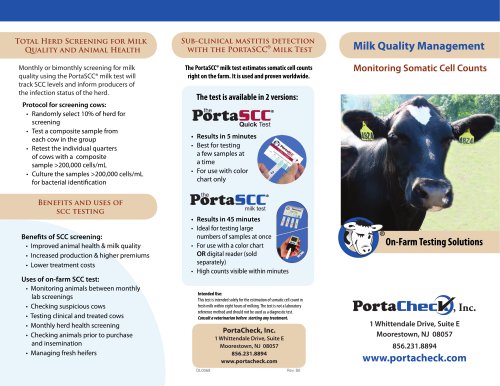
Catalog excerpts

Cell Count (cells/mL) Some sources suggest that healthy animals should have a somatic cell count less than 1,000 cells/mL On-farm somatic cell count: Screening for mastitis in dairy goats A somatic cell count test is used to indicate evidence of infection and provide a picture of overall udder health. On-farm somatic cell count tests can be useful screening tools to help dairy goat producers manage their herds and improve milk quality. Early mastitis detection may help your operation in many ways: • increase milk yield • lower treatment costs • increase premiums • reduce culling rate Goals of somatic cell testing: • Improve overall herd health (by monitoring individual animals) • Lower bulk tank cell count (by keeping high count milk out of the tank) SCC test results: What do they mean? Somatic cell counts are widely used as an evaluation tool for milk quality and as an indicator of udder health. Intramammary infection is the major cause of elevated somatic cell counts (SCCs) in dairy ruminants. In order to assure quality milk supplies, milk producers are held to "maximum level standards" by health officials. The US Food and Drug Administration (FDA) has set allowable maximum levels of SCC for Grade A Goat milk at 1,000,000 cells/mL. Herd Management decisions should not be based on the results of one test alone. The following are useful guidelines for interpreting somatic cell test results in your herd. Testing Goat Milk The industry standard for counting somatic cells in goat milk is the Green Stain. This is a microscopic method that differentiates between cells and cellular debris, both of which are shed in the milk. However, it is a complex process that can only be performed in a laboratory by trained professionals. On-farm somatic cell tests allow dairy producers to make management decisions in a timely manner without sending samples to the laboratory and waiting for results. The PortaSCC® goat milk test is a simple and reliable on-farm method for testing milk from individual goats. This test has been validated against the Green Stain, and field tested by dairy goat producers, processors and university researchers. 1 Whittendale Drive, Suite E • Moorestown, NJ 08057 856.231.8894 • www.portacheck.com Educational material provided by David L. Lee, Professor Rutgers University, Cooperative Extension Photographs courtesy of P&P High Farm
Open the catalog to page 1
Factors to keep in mind when interpreting SCC test results: Sometimes somatic cell counts increase due to non-infectious factors. Certain factors that may increase the somatic cell counts in goat milk are: • Days in lactation • Parity • Variability before, during and after milking • Acidosis and high-grain feeding • CAE • Breed effects • Teytracyclines • Some nutritional supplements Tip: One useful way to distinguish between udder health and other factors affecting SCC in goat milk is to compare SCC from each udder half in the same animal. If both tests are high, factors other than udder...
Open the catalog to page 2All PortaCheck catalogs and technical brochures
-
Portacheck RAINBOW
2 Pages
-
PortaSCC Flyer
2 Pages
-
Glucose Monitoring Brochure
2 Pages
-
Ketosis Monitoring Brochure
2 Pages
-
PortaCheck Products Brochure
4 Pages
-
PortaSCC
2 Pages
-
UdderCheck
1 Pages
-
PortaBHB
1 Pages
-
BHBCheck
2 Pages











